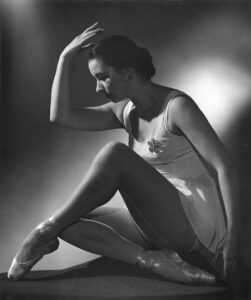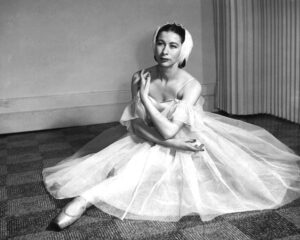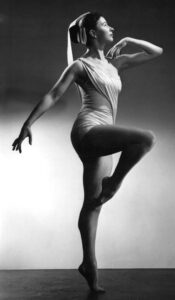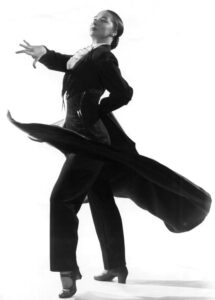kAY ARMSTRONG
1921-2008
A PAGE IN HISTORY
BIOGRAPHY
Born: September 22, 1921, Armstrong, British Columbia
Died: September 25, 2008, Vancouver, British Columbia
Birth Name: Kathleen Mae Armstrong
Kay Armstrong began dance classes in Vancouver with Helen Crewe followed by brief studies in the Okanagan Valley with Mary Pratton. She continued her training in Vancouver in the 1940s with the renowned teacher June Roper, who sent over seventy students to careers with various ballet companies including the Ballets Russes. Other of her teachers include Princess Sylvia Arfa, the daughter of the Persian ambassador to the Romanoff court and a Cecchetti diploma holder who lived in Vancouver during World War II, and Dorothy Wilson who took over Roper’s B.C. School of Dancing in 1941.
In 1946 Armstrong found work in the ballet troupe of Radio City Music Hall in New York City. She returned to Vancouver in 1947 succeeding Wilson as principal of the B.C. School of Dancing. In 1948 she and her dancers were selected to perform her choreography Masquerade Ball at the 1948 Canadian Ballet Festival. Unfortunately, the Winnipeg flood of April 1948 prevented Armstrong’s group from attending the festival.
In 1950, she formed Le Ballet Concert, which performed in the 1950 Canadian Ballet Festival. Her company danced Étude and Le Rêve Fantasque which were both included on New York critic Anatole Chujoy’s list of favourite pieces from the festival. Her work Étude was brought into the repertoire of the recently formed National Ballet of Canada by Artistic Director Celia Franca and included in the company’s 1951 debut. In fact, it was Franca who likened Armstrong to Anthony Tudor in an article published in the RAD Gazette where she wrote of Armstrong, “Like Tudor, she is interested in psychological studies and combines the classical and modern techniques …”. Étude was described by Chujoy as an abstract ballet and he noted how well trained the dancers were. Le Rêve Fantasque was a morality play about a girl who goes to the big city to seek fame and fortune. Armstrong played the lead and Chujoy described her performance as having “fine conviction” and “excellent authority”. Armstrong also designed many of the costumes for her works. A piece at the 1952 Canadian Ballet Festival, for which Armstrong received critical acclaim for her dancing, was London Fantasia about a bride and groom who are killed in the WWII air raids over London and whose spirits return to envy the surviving lovers. Other choreographic works from the 1950s, such as The Legend of the Black Swan and Stanley Park Sketches, were inspired by regional themes. Armstrong also danced and choreographed for the musicals produced by Vancouver’s Theatre Under the Stars in the 1950s.
Her group performed in many local productions throughout the 1950s and toured British Columbia and Alberta in 1954. Remarkable as a pedagogue and a choreographer, Armstrong was awarded the Ralph Hiltz award for choreography five times, and she received a citation for teaching in 1978 from the Dance in Canada Association. She closed her studios in 1989 but continued to teach weekly classes at a local community centre.
CONTENTS
- photographs, house and souvenir programmes, magazines, audio recordings, 8mm film, correspondence, research notes made by Lawrence Adams.
NOTABLE
- 8 mm film of Étude
- audio recordings of music for Black Swan composed by Marjorie David and Stanley Park Sketches composed by Linda Splatt
- 1950 Third Canadian Ballet Festival Souvenir Programme
- 1952 Fourth Canadian Ballet Festival Souvenir Programme
- photograph of Guy Glover taken while he visited Armstrong’s studio for the 1952 Canadian Ballet Festival adjudications
- issues of Canadian Art, Vol. 8, No. 3, Spring 1951 featuring Guy Glover’s article “Reflections on Canadian Ballet, 1950”
- issue of The Royal Academy of Dancing Gazette, February 1951, featuring Celia Franca’s article “Canadian Ballet Festival, 1950”
CROSS REFERENCES
PORTFOLIOS
- Basil Hunter, Harry Locke
ORAL HISTORY
- Kay Armstrong (5 hours, interviews conducted by Sonja Barton)
BOOKS
- Pepper, Kaija. 2000. In Susan Macpherson, ed. Encyclopedia of Theatre Dance in Canada/Encyclopédie de la Danse Théâtrale au Canada. Toronto: Dance Collection Danse Press/Presse. ISBN: 0-929003-42-X.
- Pepper, Kaija. 2001. The Dance Teacher: A Biography of Kay Armstrong. Toronto: Dance Collection Danse Press/Presse.ISBN: 0-929003-43-8.
WORKS
- A Night in Spain (1947)
- Pink Lady Waltz (1948)
- Kapering Kittens (1948)
- Masquerade Ball (1948)
- Caucasian Sketch (1948), Mikhail Ippolitov-Ivanov
- Première Ballade (1949), Frédéric Chopin
- The Twelve Dancing Princesses (1949)
- Étude (1949), Piotr Tchaikovsky
- Le Rêve Fantasque (1950), Dolores Claman
- London Fantasia (1951), Clive Richardson
- La Maliciosa (1952), Maurice Ravel
- Colonnade (1952), Claude Debussy
- Ballet Royale (1952), Giacchino Rossini
- The Old Woman in the Shoe (1953)
- Coronation Ballet (1953), Giacomo Meyerbeer, Richard Strauss
- Heart’s Garden (1953), Marjorie David
- Chopiano (1954), Basil Hunter
- Pacific Rhapsody (1954), Basil Hunter
- Serenade of a Minx (1954), Basil Hunter
- Waldo’s Whirl (The Marionette Shop) (1954), Marjorie David
- Scherzo (1954), Anton Dvorak
- The Black Tulip (1954)
- The Little Match Girl (1954)
- Granada Arabe (1954), Vincente Gomez
- L’Artiste du Boulevard (1954), Charles Lecocq
- Masquerade (1954), Aram Katchaturian
- Stanley Park Sketches (1956), Linda Splatt
- Allegro (1956), Maurice Ravel
- The Legend of the Black Swan (1957), Marjorie David
- Puss in Boots (1959)
- Twelve Dancing Princesses (1968), Sonja Zarek
- Lamme (1968), Sonja Zarek
PERSONNEL
Miriam Adams, C.M.
Co-founder/Advisor
Amy Bowring
Executive and Curatorial Director
Jay Rankin
Administrative Director
Vickie Fagan
Director of Development and Producer/Hall of Fame
Elisabeth Kelly
Archives and Programming Coordinator
Michael Ripley
Marketing & Sales Coordinator
CONTACT
1303 – 2 Carlton St.
Toronto, ON
M5B 1J3
Canada
Phone: 416-365-3233
Fax: 416-365-3169
info [AT] dcd.ca
HOURS
Mon. – Fri. 10 a.m. – 5 p.m.
Appointment Required
Contact our team by email or call one of the numbers above












